Detecting Muons
Detecting Muons lucas
As the name “Compact Muon Solenoid” suggests, detecting muons is one of the most important tasks of CMS. Muons are charged particles that are just like electrons and positrons, but 200 times heavier. We expect them to be produced in the decay of a number of potential new particles; for instance, one of the clearest "signatures" of the Higgs Boson is its decay into four muons.
Because muons can penetrate several metres of material losing little energy, unlike most particles, they are not stopped by any of CMS calorimeters. Therefore, chambers to detect muons are placed in the outer part of the experiment where they are the only particles likely to produce a clear signal.
A particle is measured by fitting a curve to the hits registered in the four muon stations, which are located outside of the magnet coil, interleaved with iron "return yoke" plates. The particle path is measured by tracking its position through the multiple active layers of each station; for improved precision, this information is combined with the CMS silicon tracker measurements. Measuring the trajectory provides a measurement of particle momentum. Indeed, the strong magnetic field generated by the CMS solenoid bends the particle's trajectory, with a bending radius that depends on its momentum: the more straight the track, the higher the momentum.
In total there are 1400 muon chambers: 250 drift tubes (DTs) and 540 cathode strip chambers (CSCs) track the particle positions and provide a trigger, while 610 resistive plate chambers (RPCs) and 72 gas electron multiplier chambers (GEMs) form a redundant trigger system, which quickly decides to keep or discard the acquired muon data. Because of the many layers of detector and different specialities of each type, the system is naturally robust and able to filter out background noise.
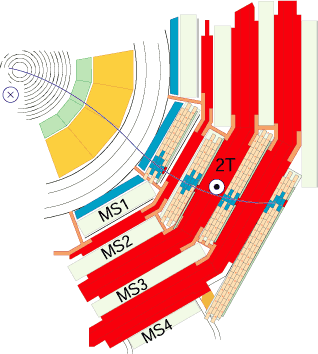
A muon, in the plane perpendicular to the LHC beams, leaves a curved trajectory in four layers of muon detectors ("stations")
DTs and square-shaped RPCs are arranged in concentric cylinders around the beam line (‘the barrel region’), whilst CSCs, trapezoidal RPCs, and GEMs form the ‘endcap’ disks that “close” the ends of the barrel.
The muon system…
- contains 2 million cathode strip chamber wires each as thin as a human hair;
- is aligned with the central tracker to within one sixth of a millimetre in order for the detectors to work together in reconstructing tracks;
- is made of components built in 15 countries. As of today, the muon system group counts 63 institutions from 22 countries.
Making Tough Chambers
Most of the muon chambers were built in different laboratories around the world before being shipped all the way to CERN, so the chambers needed to be robust as they are meant to act as precision detectors. Their mechanical robustness and performance was extensively tested in several phases of prototyping, design, test beams, assembly and commissioning, both at the respective labs and at CERN.
As a demonstration of their robustness, when physicists overseeing the beam test decided to reposition a chamber, one side of its support structure suddenly fell by more than 30 cm. Such an unprecedented test of robustness had the physicists worry about the fate of that unlucky chamber. Instead, they found it was still "taking data" in spite of its hard drop.
Visit the link for muon system updates: https://cms.cern/index.php/tags/cms-muons-subsystem
Cathode Strip Chambers
Cathode Strip Chambers lucas
Cathode strip chambers (CSC) are used in the endcap disks where the magnetic field is uneven and particle rates are higher than in the barrel.
CSCs consist of arrays of positively-charged anode wires crossed with negatively-charged copper cathode strips within a gas volume. When muons pass through, they knock electrons off the gas atoms, which flock to the anode wires creating an avalanche of electrons. Positive ions move away from the wire and towards the copper cathode, also inducing a charge pulse in the strips, at right angles to the wire direction.
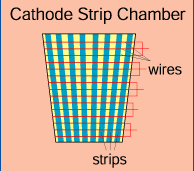
Because the strips and the wires are perpendicular, we get two position coordinates for each passing particle.
In addition to providing precise spatial and timing information, the closely spaced wires make the CSCs fast detectors suitable for triggering. Each CSC module contains six layers making it able to accurately identify muons and match their tracks to those in the tracker.
Visit the link for CSC updates: https://cms.cern/tags/csc
GEMs (Gas Electron Multiplier)
GEMs (Gas Electron Multiplier)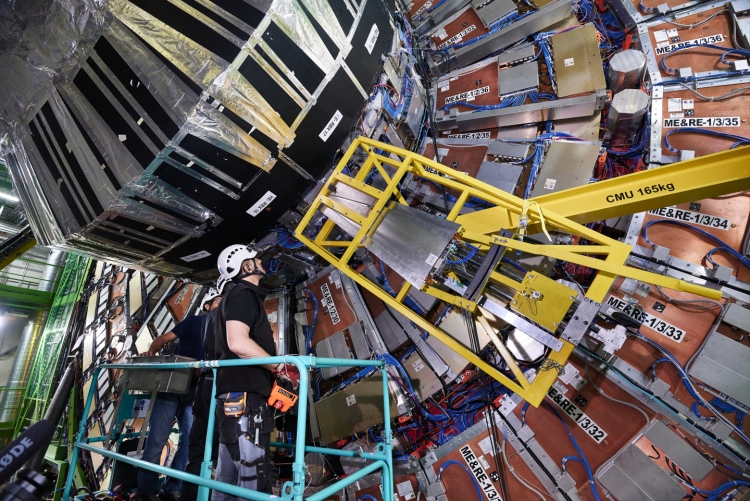
Gas electron multipliers (GEMs) are a new addition to the CMS muon system. They complement existing detectors in the forward regions close to the beampipe, where large radiation doses and high event rates will increase during Phase-2 of the LHC. The harsh environment imposes strict requirements on detector characteristics, requiring technologies with high rate capabilities–hence the choice of GEMs. In the endcaps, the GEM system will improve the measurement of the polar muon bending angle, allowing the trigger of the muon system to cope with the high rates. Additionally, GEMs will further extend the muon system coverage in the very forward regions.
Like the other CMS muon subsystems, GEMs are gaseous detectors. Their key feature is the GEM foil, which consists of a 50 micrometer-thick insulating polymer (polyimide) surrounded on the top and bottom with copper conductors. Throughout the foil, microscopic holes are etched in a regular hexagonal pattern. The CMS GEM chambers consist of two PCBs, containing the gas volume, and a stack of three GEM foils in between. The chambers are filled with an Ar/CO2 gas mixture, which is ionized by incident ionizing particles. A potential difference applied across the foils generates sharp electric fields in the holes. The electrons created during the ionisation process drift towards the foils and are multiplied in the holes. The resulting electron avalanche induces a readout signal on the finely spaced strips.
The CMS GEMs are the first GEM chambers with such a large size (an area of about 0.5 m^2) and the largest GEM system ever installed. A first batch of 144 chambers was installed during Long Shutdown 2 on the first disk of the two endcaps. These chambers will contribute to data-taking from Run-3 of the LHC. Additionally, two more disks of GEM chambers will be installed in each endcap during 2024-2026, before Phase-2 of the LHC.
https://ep-news.web.cern.ch/cms-gems-are-changing-gear
https://ep-news.web.cern.ch/content/demonstrating-capabilities-new-gem
https://home.cern/news/news/experiments/ls2-report-144-new-muon-detecto…
Visit the link for GEM updates: https://cms.cern/tags/gems
Muon Drift Tubes
Muon Drift Tubes lucas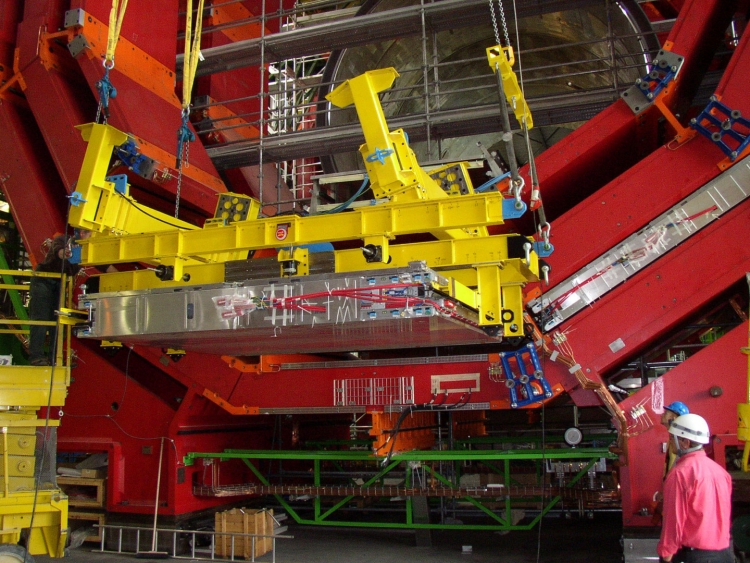
The drift tube (DT) system measures and identifies muon tracks in the barrel part of the detector. Each 4cm-wide tube contains a stretched wire within a gas volume. When a muon or any charged particle passes through the volume, it knocks electrons off the atoms of the gas. These electrons “drift” towards the anode following the electric field, ending up at the positively-charged wire where they are amplified and produce a measurable charge pulse. Each unit or “superlayer” contains four layers of staggered drift cells.
By registering the time taken by the electrons to reach the wire, and since the drift velocity along the cell is a rather constant value, we can identify the exact crossing point of the muon along the cell. Each superlayer provides 4 points in 2D for the muons position.

The sizes of DT chambers range from 2m x 2.5m to 4m x 2.5m, approximately. Each chamber consists of 8 or 12 aluminium layers, arranged in two or three superlayers, each up with up to 90 tubes: the middle superlayer measures the coordinate along the direction parallel to the beam and the two outside superlayers measure the perpendicular coordinate, thus providing a combined 3D measurement of the muon track.
Visit the link for Drift Tubes (DTs) updates: https://cms.cern/tags/drift-tubes
Resistive Plate Chambers
Resistive Plate Chambers lucas
Resistive Plate Chambers (RPCs) are fast gaseous detectors that provide a muon trigger system parallel to those of the DTs and CSCs.
RPCs consist of two parallel plates, a positively-charged anode and a negatively-charged cathode, both made of a very high resistivity plastic material and separated by a thin gas volume.
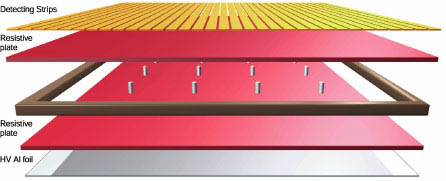
When a muon passes through the chamber, electrons are knocked out of the atoms of the gas. These electrons in turn hit other atoms causing an avalanche of electrons. The electrodes are transparent to the signal (the electrons), which are instead picked up by external metallic strips after a small but precise time delay. The pattern of hit strips gives a quick measure of the muon's momentum, which is then used by the trigger to make immediate decisions about whether the data are worth keeping. RPCs combine a good spatial resolution with a time resolution of just one nanosecond (one billionth of a second).
Visit the link for RPC updates: https://cms.cern/tags/rpc